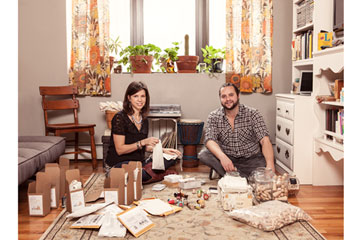
(2 of 6)
The central battlefield for the future of the handmade movement is Etsy, which sold nearly $900 million in merchandise last year. The site has helped its legions of handicrafters prosper in a weak economy. It has even been hailed by New York Senator Chuck Schumer as a new paragon of job creation. But disenchanted members say that the bigger Etsy gets, the more it tramples over smaller producers and dilutes the charm of handmade goods. "This is a movement that pimps out a 'Quit your day job' mantra," says April Winchell, a blogger popular for her critiques of Etsy and its products. "People's livelihoods are at stake, and that makes for a lot of anxiety and unhappiness."
Machine-made, mass-produced goods have been a way of life since the Industrial Revolution. When they first emerged, they were widely coveted; handmade items suddenly seemed cheap and unfashionable. But from the antimaterialism of hippies in the 1960s and '70s to Martha Stewart's homemaking revival in the '80s and '90s, craftsmanship has given solace to those seeking relief from modernity. Buyers and sellers would find each other at farmers' markets and church-hall craft fairs.
The Internet, of course, changed all that, vastly expanding the reach of handicrafts. Yahoo provided digital storefronts and credit-card checkouts, while eBay, Amazon and other online giants promoted the idea of the flea-market millionaire, allowing small-town candlemakers in Utah or Kansas to sell their wares anywhere. But an even bigger turning point came in 2005, when Rob Kalin had the idea that would become Etsy.
Kalin was a 24-year-old underemployed classics graduate from New York University, living a life of hipster values, quaint and cool. He made and painted his own furniture in a walk-up apartment in Brooklyn. With two college friends, he launched Etsy--a name, Kalin says, that was purely nonsensical--without a business plan or, really, any plan other than to give small-time artisans a chance to become entrepreneurs without sacrificing their artsy ethos. "It was a 'Hey, we make stuff, and there's nowhere good to sell it' kind of place," says Matt Stinchcomb, Kalin's onetime roommate and now Etsy's vice president of values and impact. (In his roles, according to the company's website, Stinchcomb has been expected to "keep us all honest and host a dance party or two.")
Etsy found a huge untapped market, and within its first two years it grew to 50,000 sellers and nearly $10 million in sales. Before long, it attracted as much attention from elite venture capitalists as from craftspeople. In 2008, Etsy announced a $27 million investment from, among others, Union Square Ventures and Accel Partners, investors in Facebook, Twitter and Tumblr.
